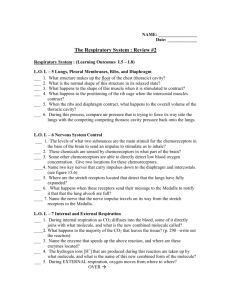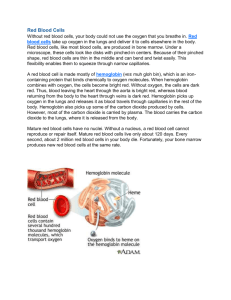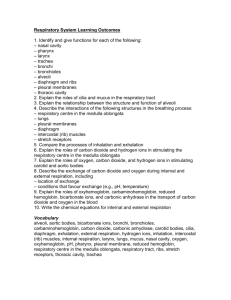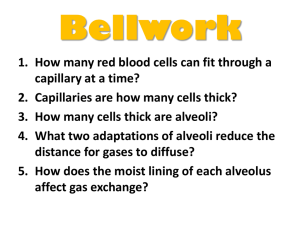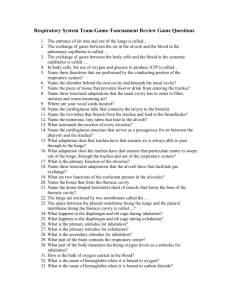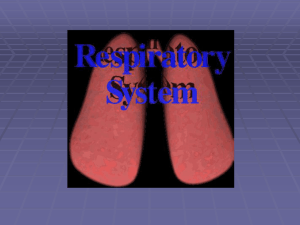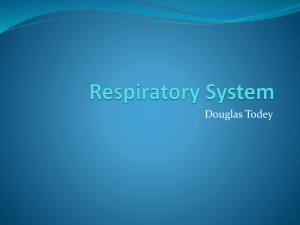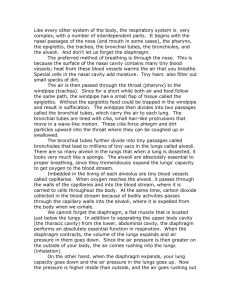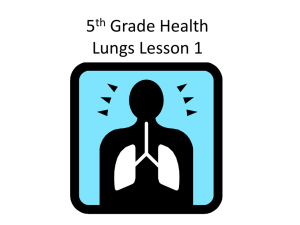File
advertisement
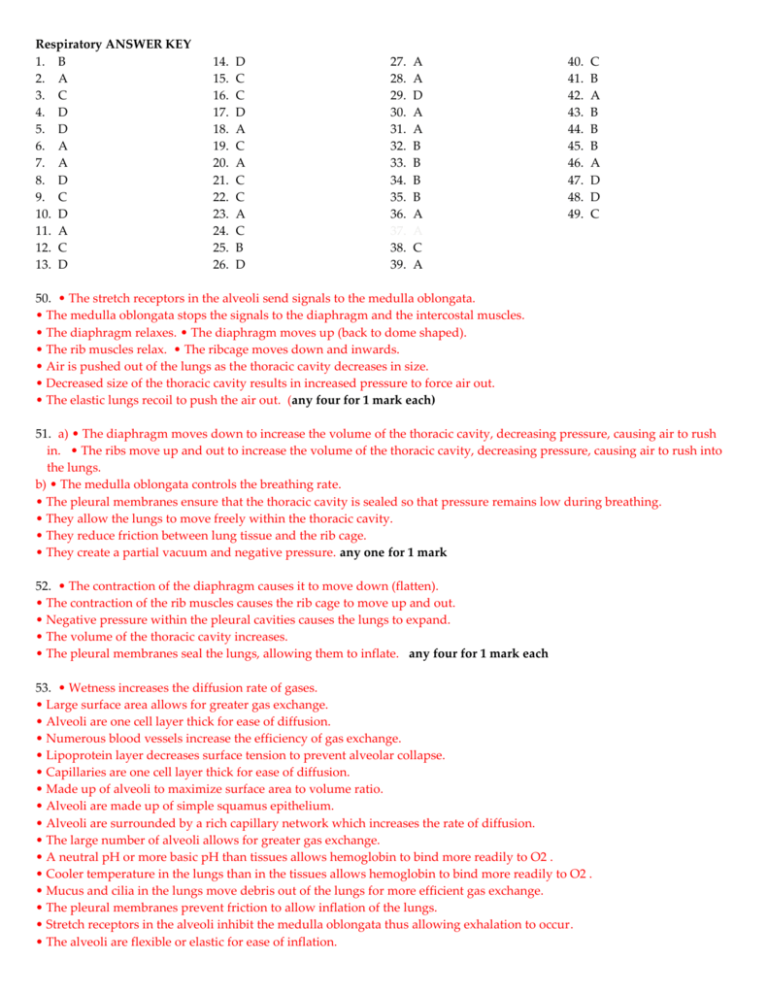
Respiratory ANSWER KEY 1. B 2. A 3. C 4. D 5. D 6. A 7. A 8. D 9. C 10. D 11. A 12. C 13. D 14. 15. 16. 17. 18. 19. 20. 21. 22. 23. 24. 25. 26. D C C D A C A C C A C B D 27. 28. 29. 30. 31. 32. 33. 34. 35. 36. 37. 38. 39. A A D A A B B B B A A C A 40. 41. 42. 43. 44. 45. 46. 47. 48. 49. C B A B B B A D D C 50. • The stretch receptors in the alveoli send signals to the medulla oblongata. • The medulla oblongata stops the signals to the diaphragm and the intercostal muscles. • The diaphragm relaxes. • The diaphragm moves up (back to dome shaped). • The rib muscles relax. • The ribcage moves down and inwards. • Air is pushed out of the lungs as the thoracic cavity decreases in size. • Decreased size of the thoracic cavity results in increased pressure to force air out. • The elastic lungs recoil to push the air out. (any four for 1 mark each) 51. a) • The diaphragm moves down to increase the volume of the thoracic cavity, decreasing pressure, causing air to rush in. • The ribs move up and out to increase the volume of the thoracic cavity, decreasing pressure, causing air to rush into the lungs. b) • The medulla oblongata controls the breathing rate. • The pleural membranes ensure that the thoracic cavity is sealed so that pressure remains low during breathing. • They allow the lungs to move freely within the thoracic cavity. • They reduce friction between lung tissue and the rib cage. • They create a partial vacuum and negative pressure. any one for 1 mark 52. • The contraction of the diaphragm causes it to move down (flatten). • The contraction of the rib muscles causes the rib cage to move up and out. • Negative pressure within the pleural cavities causes the lungs to expand. • The volume of the thoracic cavity increases. • The pleural membranes seal the lungs, allowing them to inflate. any four for 1 mark each 53. • Wetness increases the diffusion rate of gases. • Large surface area allows for greater gas exchange. • Alveoli are one cell layer thick for ease of diffusion. • Numerous blood vessels increase the efficiency of gas exchange. • Lipoprotein layer decreases surface tension to prevent alveolar collapse. • Capillaries are one cell layer thick for ease of diffusion. • Made up of alveoli to maximize surface area to volume ratio. • Alveoli are made up of simple squamus epithelium. • Alveoli are surrounded by a rich capillary network which increases the rate of diffusion. • The large number of alveoli allows for greater gas exchange. • A neutral pH or more basic pH than tissues allows hemoglobin to bind more readily to O2 . • Cooler temperature in the lungs than in the tissues allows hemoglobin to bind more readily to O2 . • Mucus and cilia in the lungs move debris out of the lungs for more efficient gas exchange. • The pleural membranes prevent friction to allow inflation of the lungs. • Stretch receptors in the alveoli inhibit the medulla oblongata thus allowing exhalation to occur. • The alveoli are flexible or elastic for ease of inflation. 54. a) H2O + CO2 (diffuse into the blood from the tissues) H2CO3 (carbonic acid) H + and HCO3 Hb+H+ HHb (the excess H ions produced from the water and carbon dioxide are taken up by the hemoglobin forming reduced hemoglobin) HbO2 + Hb O2 (the oxygen diffuses into the tissues) Occurs in a warm, acidic environment (relative to the lung capillaries) Hb + CO2 HbCO2 b) Hemoglobin takes up excess H+ ions forming reduced hemoglobin at the tissues. Bicarbonate ions take up excess H+ ions at the lungs forming water and carbon dioxide. Blood is buffered by a variety of substances (including Hb, HCO3 ± , HPO4 2±, etc.) which reduces the amount of H+ ions and keeps the pH relatively constant. 55. a) • The breathing rate increases. (1 mark) b) • The medulla oblongata detects an increase in carbon dioxide concentration. (1 mark) • The medulla oblongata then sends out a nerve impulse that increases the rate of contractions of the diaphragm and intercostal muscles. (1 mark) 56. a) oxygen combines with hemoglobin to form oxyhemoglobin (O2 + Hb HbO2) (1 mark) carbaminohemoglobin releases carbon dioxide (HbCO2 Hb + CO2) (1 mark) bicarbonate ions combine with hydrogen ions to release carbon dioxide b) Blood at the lung capillaries has a lower temperature. Blood at the lung capillaries has a higher pH / less acidic. Blood at the lung capillaries has a lower oxygen concentration. Blood at the lung capillaries has a higher carbon dioxide concentration. Low amounts of hemoglobin will reduce the amount of O2 diffused per minute. Changes in blood pressure and blood velocity will affect the rate of gas exchange. any two for 1 mark each 57. • They are moist which increases the rate of diffusion of gases. • They are highly vascularized which allows more exchange of gases. • The thin walls of the alveoli allow materials to be exchanged quickly and easily. • A layer of lipoprotein reduces surface tension and prevents the alveoli from collapsing. • They are small and number in the millions. This increases their surface area and allows for speedy gas exchange. • Stretch receptors in their walls signal medulla oblongata to stop inhalation. any three for 1 mark each 58. • Carbon dioxide concentrations in the blood increase because of increased cellular respiration due to exercising. • The medulla oblongata detects the increased levels of carbon dioxide / hydrogen ions. • The medulla oblongata sends an increasing number of impulses to the diaphragm and rib muscles causing them to contract faster. • Increased muscle activity needs ATP. • Increased hydrogen ion & carbon dioxide concentration increases the breathing rate. • Muscles need more glucose. 59. a) • The lungs have a higher (7.4) pH / the tissues have a lower (7.38) pH. • The lungs are more basic / less acidic. • The tissues are more acidic / less basic. any one for 1 mark AND • The lungs have a lower (cooler) temperature / the tissues have a higher (warmer) temperature. b) • Oxygen is released more readily from hemoglobin due to the lower pH and the higher temperature. • Hemoglobin is denatured and releases oxygen at a lower pH and a higher temperature. either one for 1 mark c) • pH would decrease • increased lactic acid concentration • temperature would increase • increased hydrogen ions (H+) • more oxygen released from hemoglobin • more waste (CO2 ) • decreased oxyhemoglobin (HbO2) in blood • sweating causes decreased blood volume • greater concentration of bicarbonate ions in blood • blood velocity increases • increased carbaminohemoglobin (HbCO2) produced • increased solute concentration due to sweating • more reduced hemoglobin (HHb) would be produced
